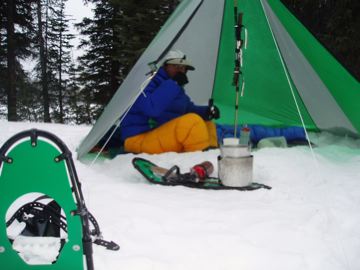Editor’s note: Don ‘Photon’ Johnston is a stove ‘geek’ and the inventor of the Photon Stove ™ alcohol stove. What follows is his advice based on over 10 years of MSR white gas stove use and observation.

The author using an MSR WhisperLite Internationale (the original Shaker Jet model) to melt snow in the Beartooth Mountains of Montana. This older stove is still going strong after minimal maintenance.
MSR stoves are easy to maintain: it’s one of their most valuable features. No matter what happens in the field with your MSR stove, you will never miss a hot meal if you have done a little homework.
General MSR white gas stove advice:
- Get and carry the repair kit. Get the expedition version so you have available at home every part you might ever need and bring on trips only the parts that experience or fear tells you that you need to carry from it.
- Practice field repair at home. If you don’t have an instinct for mechanical things such that you rarely need instructions to do stuff, then practice field maintenance at home with long periods of forgetfulness between practices to make sure you have cleaning and O-ring replacements down. Know where the parts go and in what order. Know where the different sized O-rings go (which isn’t very hard if you only carry the two sizes I have actually used: the fuel bottle O-ring and the fuel tube O-ring that fits in the pump).
Things to expect based on my past MSR experience:
The fuel bottle O-ring will rarely need replacement; carry no more than one spare since it is most likely to expire from old age rather than damage. The fuel tube to pump O-ring is the most likely to need replacement; carry more than one spare until you know how things work out for you. Some folks have a problem with damaging this O-ring and others rarely have a problem. Carry a spare pump cup even though you probably won’t need it. The pump cup, the two O-rings I mentioned, and the tool from the repair kit are the minimum and probably all you will need in the field. You may want to carry additional items just in case your home checkout of the stove before packing isn’t up to par.
Always follow the directions for inserting the fuel tube in the fuel bottle so you don’t mess up that O-ring. If the pump doesn’t seem to be pumping, you can remove the plunger and flex the pump cup out wide a few times to restore it to full function. Only if it is damaged do you need to replace it. The repair kit comes with pump cup oil you can apply at home. You won’t need it in the field. The shaker jet works well but may not always be enough, so you need to be comfortable using the cleaning wire in the fuel tube and removing and cleaning the jet.
Clean fuel will mean you rarely have to clean the stove and may never need to disassemble it in the field. When filling the fuel bottle, pour the fuel through one of the Coleman fuel funnels that has a felt filter rather than a wire screen in the bottom. Very few times over the 10 or more years I’ve used an MSR have I had to disassemble or replace a part in the field. The shaker jet eliminated almost all stove problems in the field. Other field repairs only became necessary because I was lazy and didn’t check things before trips. A fuel bottle O-ring that was expiring once needed replacement after many, many years of service. Maybe twice I have replaced the fuel tube O-ring. I swapped out the pump cup once with the spare one in the kit I was carrying. The pump felt like it was sliding too easily and I couldn’t really pump up the pressure with it. The cup in the kit, not being restricted by the pump walls, had taken a set that was larger in diameter than the set of the cup in the pump. I figured the pump cup from the kit would seal a little better to the pump wall, and it did. After that, rather than replacing a pump cup in the field, I started just flexing the cup wide the first day out and, if needed, later on during the trip. I have never needed to replace a check ball, spring, or jet.
SimmerLite quirks I have seen to watch out for:
- The pump, like all MSR pumps, has plastic tubes that extend inside the fuel bottle. The long flexible one needs to angle away from the pump and rest against the inside of the fuel bottle wall. This is the fuel pickup tube and needs to rest on the bottom of the fuel bottle when attached to the stove so that it will use up all the fuel in the bottle. I saw one where the tube did not have enough bend in it to reach the sidewall. Even though the fuel bottle was not all that near empty, the stove would not stay burning because it was not getting a steady supply of fuel. When inserting the pump into the fuel bottle, you flatten this tube against the pump to get it into the bottle opening and it then needs to spring back enough to reach the wall of the fuel bottle. Before inserting the pump look at this tube to see that it has enough spring in its bend to reach the sidewall. You can flex the tube out if needed to restore the proper amount of deflection.
- I once saw a problem with the cleaning wire in the fuel tube. The wire is made from twisted wire cable commonly referred to as aircraft cable. I have never heard of or seen this problem except in a SimmerLite I saw this summer. After the cable had been removed as part of the cleaning procedure, it could not be pushed back in. The cable had lost some of the temper that maintained the wire twist and when pushing it into the fuel tube, the friction from pushing the wire around the bends caused the wire to untwist slightly and expand, increasing the friction until it could not be pushed any further. If this happens in the field, the stove will still work without this wire inserted or with the excess wire you could not push in cut off with wire cutters, if you carry them. Make sure you leave some wire extending out so you can remove the cut wire when you get a replacement. To use it this way, pump less pressure into the fuel bottle than you ordinarily would. Removing the wire reduces the restriction to fuel flow and MSR recommends less pressure in the fuel tank to compensate. (MSR will replace any defective part for free and even mail it to the post office of your choice. Just call them when you get to a phone.)
Conclusion
MSR white gas stoves are reliable (especially if you use clean fuel) and easy to maintain. With a minimal amount of knowledge, some practice at home, and preparation (purchasing and carrying a few spare parts and a tool, and checking out your stove pre-trip), you can count on a hot meal in the field with your MSR stove.

Don has been an avid backpacker since 1988 preferring week long or longer hikes. He has one section of the Appalachian Trail left to hike (planned for 2005); he has completed the John Muir Trail twice, the High Sierra Trail, the Tahoe Yosemite Trail, the Northville Placid Trail, and The Long Trail. Don is the inventor of the “Photon Stove ™” alcohol stove. He designed and owns the original Arc Alpinist sleeping quilt. Working with Kurt Russell, he prompted the construction of, and owns, the first Nomad Lite-N-Airy tent. Don is a Network Administrator at a Montgomery County, Maryland High School.


